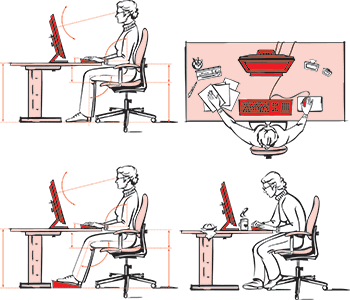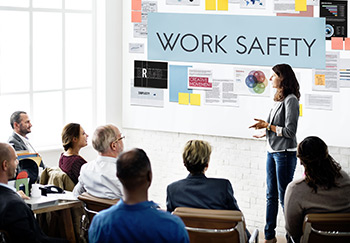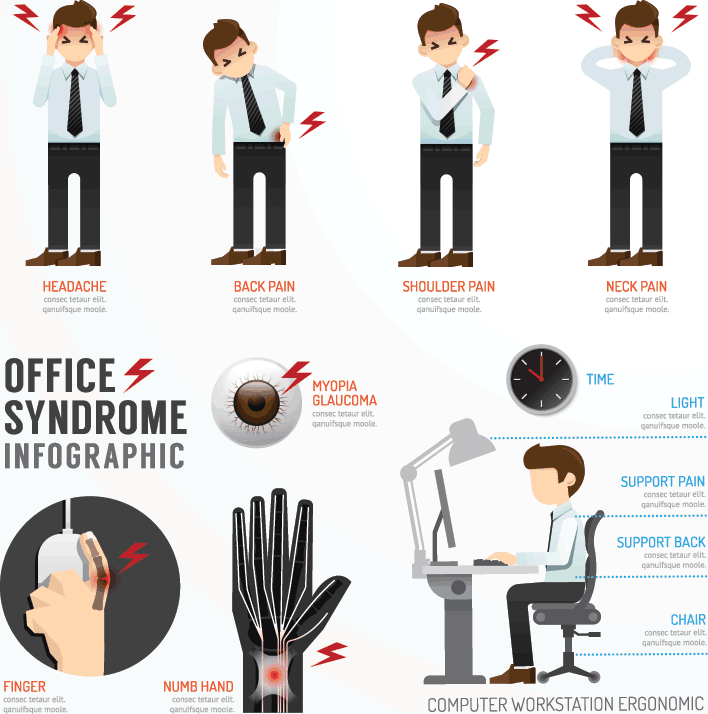If your employees are working at their desks all day, every day, it’s important to ensure adequate ergonomic procedures are in place for their safety. Prolonged sitting, in conjunction with bad posture and positioning, can be detrimental to a worker’s health and well-being both at work and at home. Using smart ergonomics will not only lead to higher productivity levels, but it will also result in a lower amount of days lost for sickness. How, you say? Well, there are a number of easy and low-cost ways to do this – we have listed the best ones below…
1. Adequate workspace

Furthermore, increasing the amount of area per person in the workplace will mean you are likely to see a decrease in both injury and illness reports. This will be due to the reduced number of hazards, the lower risk of minor illnesses spreading, and the minimised stress levels in workers – making for a happier, more desirable workplace setting.
2. Computers and monitor positions
Badly positioned monitors can force the operator to work in awkward and uncomfortable conditions, affecting both their work-rate and health. Adverse effects of poorly located monitor equipment include musculoskeletal injuries (such as neck and back pain), eye strain/irritation, blurred vision, and headaches.
To ensure minimal discomfort, all screens should be positioned at least an arm’s length away from the user, so if they reach out only the tips of their fingers can reach the monitor. Any closer and the risk of eye irritation and headaches are increased; any further away and risk of musculoskeletal pain is multiplied due to the unnatural positioning that will occur to read the screen. The top of the monitor should be no higher than eye-level.
3. Keyboard And Mouse Placement

For the mouse, it should be about shoulder-distance apart from the keyboard and as level as possible. A good idea for extra comfort is to provide all your workers with keyboard and mouse mats with comfortable protective gel sponge rests for their wrists.
4. Encourage short breaks
Constant daily work can be very stressful and things can become incredibly overwhelming in a short period of time. This is one of the common reasons for employee ‘burnout’ to occur – which can cause even the most productive and focused workers to become worn-out and unsuccessful. As an employer, encouraging staff breaks (in addition to their lunch break) enables your workers to adopt a number of positive health benefits and gain a refreshed outlook on the work at hand. Some benefits of regular, short breaks include:
- Improve perspective on general workload
- Creativity boost
- Increased blood circulation
- Reduced eye strain
- Fewer distractions during the day
- Lower stress levels & an opportunity to refuel
5. Provide Appropriate Training

Workers should be educated on how to remain safe and healthy at their desk, especially if they spend a majority of their time there. Offering ergonomics training to your members of staff will make a world of difference to their understanding of their daily wellbeing and how to improve their life for now and for the future. ‘Healthy Working’ is the most widely used ergonomics e-learning software which can be carried out in the comfort of your own office and to the workers own schedule. This self-assessment software will help manage employee discomfort, and for you, provide a significant return on investment.
6. Reduce The Risk Of Eye-Strain
Eye strain can be caused by a number of factors. The most common reason for this health complication comes from employees having to look at computer screens for the majority of their working day. Encourage workers to set their screen brightness to a low, comfortable setting and take regular eye breaks.
There is a 20,20,20 rule which should be supported in the workplace – every 20 minutes, look at something at least 20 feet away for at least 20 seconds. This method is proven to reduce the effects of computer eye strain. You could encourage your employees to take a walk around the office, take turns in making the teas and coffees, visiting other parts of the building or getting involved in an office team activity that doesn’t involve computers.
7. Provide Suitable Desks And Chairs
When choosing office furniture, it’s important to take all employees into consideration and not just the general individual. We recommended that adjustable desks and ergonomic chairs are purchased in order to suit all users, as the majority office furniture fails to achieve ‘one size fits all’. Workers should feel comfortable at their desks, with chairs suitable for prolonged sitting.
Desks should be placed at elbow height, allowing arms and elbows to remain at a right angle whilst using the keyboard. Feet should be flat on the floor with knees comfortably at a right-angle position. Backs should be straight and necks in a relaxed position, reducing shoulder pain, lower back pain, fatigue, and allowing a more alert workforce.








0 Comments